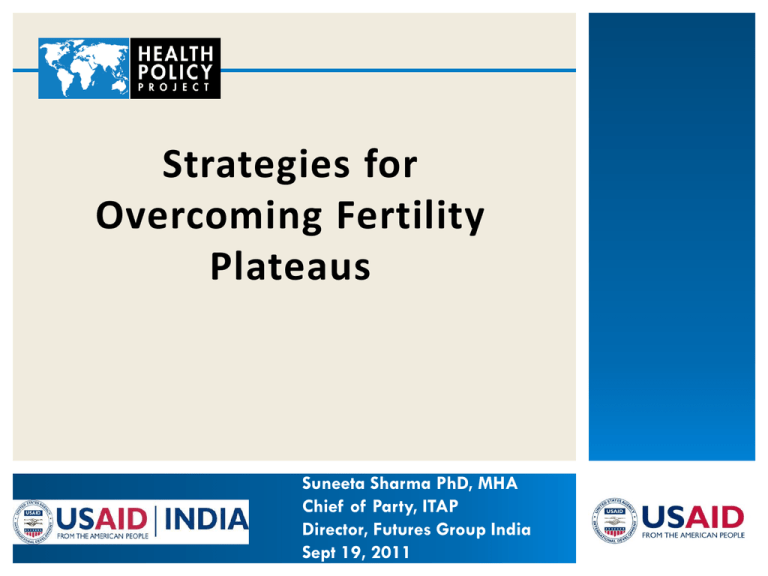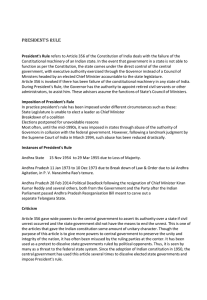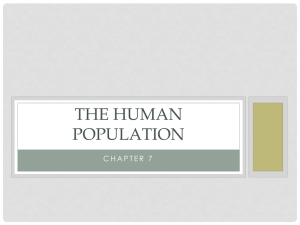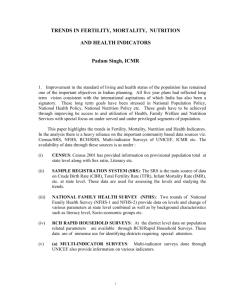Strategies for Overcoming Fertility Plateaus
advertisement

Strategies for Overcoming Fertility Plateaus Suneeta Sharma PhD, MHA Chief of Party, ITAP Director, Futures Group India Sept 19, 2011 Plateauing CPR: Three Stages Beginning of the program After take off After reaching the ceiling Slackened Pace of CPR Modern Contraceptive Prevalence Rate, Bangladesh 50 45 40 35 30 25 20 15 10 5 0 Modern Contraceptive Prevalence Rate, India 60 50 40 30 Average Annual Increase 1991-2004: 1.24 2004-2007:0.07 20 10 Average Annual Increase 1992-98: 1.05 1999-2005: 0.9 0 1991 1994 1997 2000 2004 2007 Source: Demographic Health Surveys 1992-93 1998-99 2005-06 Source: National Family Health Surveys Questions on Plateauing Why do programs plateau? How long do they remain stagnant? What has been done or needs to be done to get out of such situations? Is it possible to predict such situations in advance? Reasons Behind Slackened Pace of CPR A limited method mix Program management weaknesses Sheer growth of numbers Changing demographic profile within the reproductive years Shift in attention to other programs Diminishing returns at high prevalence rates Source: John Ross et al Plateaus during the Rise of Contraceptive Prevalence, IFPP, 2004 Reasons for the Stall in Fertility Changes in fertility preferences such as shifts in marriage patterns, timing of initiating child bearing Shifts in local/national policies, reduced budgets or donor support Increasing unmet need, unplanned childbearing Increasing negative attitudes towards family planning or methods Changes in age structure of population and migration Source: Ian Askew et al, Pop Council 2009 Can plateauing be anticipated? Case of India Total Fertility Rate in Indian States Bihar Uttar Pradesh Rajasthan Madhya Pradesh Jharkhand Chhatisgarh Assam INDIA Haryana Gujarat Orissa Jammu & Kashmir Delhi Maharashtra Karnataka Himachal Pradesh West Bengal Punjab Andhra Pradesh Tamil Nadu Kerala 3.9 3.8 3.3 3.3 3.2 3.0 2.6 2.6 2.5 2.5 2.4 2.2 2.0 2.0 2.0 1.9 1.9 1.9 1.8 1.7 1.7 0.0 0.5 1.0 1.5 2.0 TFR = 2.1, replacement level of fertility 2.5 3.0 3.5 4.0 4.5 Source: Sample Registration System, Registrar General of India, 2008 Trends in Modern Method CPR in India and Select States 67 70 58.9 60 50 48.5 42.8 46.9 46.5 40 30 56.5 53.3 36.3 29.3 28.9 22 22.4 20 18.5 10 India Andhra Pradesh 1993 Source: National Family Health Surveys (NFHS) Gujarat 1999 Uttar Pradesh 2006 21.6 Bihar Decline in Total Fertility Rate in India and Select States 4.82 5 4.5 4.06 4 3.5 3.39 3 2.85 2.5 2.68 2.59 2.25 2.42 2 1.5 2.99 2.72 3.82 4 3.7 4.0 1.79 1 India Source: National Family Health Surveys AP Gujarat 1993 1999 UP 2006 Bihar Inequities in Contraceptive Prevalence Rates 4.5 70 4 3.5 3.89 3 T 2.5 F 2 R 1.5 3.17 55.2 58.0 60 49.8 48.5 2.58 2.68 43.5 34.6 2.24 M 50 o d 40 C 30 R P 20 1.78 1 0.5 0 10 Lowest Second Middle Fourth Wealth Quintile CPR - Mod Source: National Family Health Surveys (NFHS) TFR Highest India Plateauing CPR in India Significant proportion of declines in fertility and increase in CPR have come from select states States that have achieved ceiling levels will not significantly contribute to increases in CPR and fertility decline States that have experienced plateau in the past decade have to contribute to CPR increase significantly If not, India will enter into plateauing phase this decade How to Tackle Plateaus? Analyze data sets to understand contributions of subgroups and prepare strategies Keep FP program central to development efforts Introduce new FP technologies if they are not part of current programs Involve private sector in FP service delivery Andhra Pradesh Andhra Pradesh – CPR v/s TFR 5.0 4.5 80 70 C P 60 R 67.0 4.6 4.0 58.9 4.0 3.5 47.0 3.0 T F 2.5 R 2.0 50 40 2.6 2.3 2.2 2.1 1.5 1.8 1.8 NFHS 200506 SRS 2008 1.0 0.5 0.0 M 30 o d 20 e r 10 n 0 SRS 1971 SRS 1981 NFHS 1992- NFHS 199893 99 AP TFR SRS 2003 SRS 2004 AP CPR Source: Sample Registration System and National Family Health Surveys Three Pillars of Andhra Pradesh’s Family Planning Program Political Commitment and Leadership • Mission mode implementation • State specific FP intervention under directions of State Population Policy • Leadership by Chief Minister • Supplemented central funding through special state budget • Ensured high level monitoring by the Chief Minister/Health Minister • FP as top agenda item of District Collectors’ meetings – Monthly Robust Administrative Systems and Execution • Developed a Strategic Framework to implement State Population Program • Established District Population Stabilization Societies • Identified and prioritized on poor performing districts • Designed special state- specific interventions • Provision of FP State share • Support to Camp Approach • State level mobile teams • Uninterrupted provision of supplies • Rewards for providers • Special focus on legal issues and treatment of complications • Continuation of Post Partum FP Centers Effective Monitoring and Feedback • Initiated Tele/ Video-conferencing facilities to monitor the program • Chief Minister reviewed program of all 23 districts • District Collectors reviewed and facilitated mobilization of programs Uttarakhand Example Analyze data sets to understand contributions of subgroups and prepare strategies High maternal mortality, infant mortality, and total fertility rates Use of FP methods and institutional facilities for deliveries is the lowest among poor Out-of-pocket expenditure on reproductive and child health (RCH) services Enormous health barriers to the poor Staff vacancies, lack of trained staff Difficult geographic terrain, remote populations CPR v/s TFR for Wealth Quintiles, Uttarakhand 70 C 60 P R 50 - 3.5 3.21 63.4 2.72 48.3 56.1 49.9 55.5 2.55 2.5 3 2.5 42.1 2.04 40 2 T F 1.5 R M 30 o d 20 e r 10 n 1 0.5 0 0 Lowest Second Middle Fourth TFR Highest CPR Source: Calculated from the National Family Health Survey – 3 (2005-06), Uttarakhand State Raw Data Total Keep FP program central to development efforts New Health and Population Policy (2010 2020) Increased state funding and innovative financing mechanisms Promote a balanced method mix Focused interventions in low performing districts Develop capacity of the providers and health workers Engage men to increase their participation in planned parenthood Mandatory action: Modern spacing method services to newly married and couples having one child Involve private sector in FP service delivery Mobile Health Vans ASHA plus Program Ensure sustainable financing Prioritize needs Voucher System Contracting out in urban areas 108 Vans for transportation Adolescent NGO project Determine shared goals Government Leadership and Ownership Engage right partners Develop strategic options Establish links with policy framework Develop costed scale up strategy Design and test appropriate models Evaluate impact Scaling Up Public Private Partnership Models Voucher system scaled up to 38 blocks in five districts covering more than 50 percent of the State rural population 26 Mobile Health Vans in 35 districts covering 10 million people ASHA plus program scaled up in 6 districts covering 3.13 million people I m p ac t A s s e s s m e nt o f Vo u c h e r P ro j e c t i n Hari d war, U ttarak h and ( i n 2 4 m o nt hs ) 47 50 43.1 40 30 20 10 32.8 28.9 5.9 10.6 0 3+ ANC Checkups Institutional delivery Baseline Mod CPR Endline Behaviour Change Communication Activities to Inform PPP Models Formative research to identify barriers to behavior change Workshop on BCC involving various stakeholders ASHA Plus toolkit and IPC Training BCC campaign on institutional deliveries (mass media, mid-media and IPC) Branding , BCC strategy and IPC tools for Voucher scheme Communication plan and IPC tools for mobile vans UDAAN BCC strategy, and campaign developed Workshop on strategic BCC to develop PIP 2011 -12 Way Forward Promote evidence-based process of moving from policy to action Keep family planning central to development efforts Design, test, implement, evaluate, and scale up effective interventions Plan and monitor for impact Photo by Meena Kadri Thank You! www.healthpolicyproject.com The Health Policy Project is a five-year cooperative agreement funded by the U.S. Agency for International Development (USAID) under Cooperative Agreement No. AID-OAA-A-10-00067, beginning September 30, 2010. It is implemented by Futures Group, the Centre for Development and Population Activities (CEDPA), Futures Institute, Partners in Population and Development Africa Regional Office (PPD ARO), Population Reference Bureau (PRB), Research Triangle Institute (RTI) International, and the White Ribbon Alliance for Safe Motherhood (WRA).








